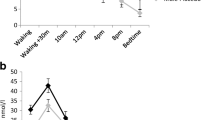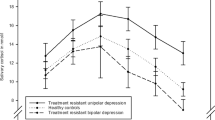Abstract
Rationale
A dysregulation of the hypothalamic–pituitary–adrenal (HPA) axis is a well-documented neurobiological finding in major depression. Moreover, clinically effective therapy with antidepressant drugs may normalize the HPA axis activity.
Objective
The aim of this study was to test whether citalopram (R/S-CIT) affects the function of the HPA axis in patients with major depression (DSM IV).
Methods
Twenty depressed patients (11 women and 9 men) were challenged with a combined dexamethasone (DEX) suppression and corticotropin-releasing hormone (CRH) stimulation test (DEX/CRH test) following a placebo week and after 2, 4, and 16 weeks of 40 mg/day R/S-CIT treatment.
Results
The results show a time-dependent reduction of adrenocorticotrophic hormone (ACTH) and cortisol response during the DEX/CRH test both in treatment responders and nonresponders within 16 weeks. There was a significant relationship between post-DEX baseline cortisol levels (measured before administration of CRH) and severity of depression at pretreatment baseline. Multiple linear regression analyses were performed to identify the impact of psychopathology and hormonal stress responsiveness and R/S-CIT concentrations in plasma and cerebrospinal fluid (CSF). The magnitude of decrease in cortisol responsivity from pretreatment baseline to week 4 on drug [delta-area under the curve (AUC) cortisol] was a significant predictor (p<0.0001) of the degree of symptom improvement following 16 weeks on drug (i.e., decrease in HAM-D21 total score). The model demonstrated that the interaction of CSF S-CIT concentrations and clinical improvement was the most powerful predictor of AUC cortisol responsiveness.
Conclusion
The present study shows that decreased AUC cortisol was highly associated with S-CIT concentrations in plasma and CSF. Therefore, our data suggest that the CSF or plasma S-CIT concentrations rather than the R/S-CIT dose should be considered as an indicator of the selective serotonergic reuptake inhibitors (SSRIs) effect on HPA axis responsiveness as measured by AUC cortisol response.



Similar content being viewed by others
References
Attenburrow MJ, Mitter PR, Whale R, Terao T, Cowen PJ (2001) Low-dose citalopram as a 5-HT neuroendocrine probe. Psychopharmacology 155:323–326
Barden N, Reul JM, Holsboer F (1995) Do antidepressants stabilize mood through actions and the hypothalamic–pituitary–adrenocortical system? Trends Neurosci 18:6–11
Bhagwagar Z, Whale R, Cowen PJ (2002) State and trait abnormalities in serotonin function in major depression. Br J Psychiatr 180:24–28
Bowie PC, Beaini AY (1985) Normalization of the dexamethasone suppression test: a correlate of clinical improvement in primary depressives. Br J Psychiatr 147:30–35
Brady LS, Gold PW, Herkenham M, Lynn AB, Whitfield HJ Jr (1992) The antidepressants fluoxetine, idazoxan and phenelzine alter corticotropin-releasing hormone and tyrosine hydroxylase mRNA levels in rat brain: therapeutic implications. Brain Res 572:117–125
Budziszewska B, Siwanowicz J, Przegalinski E (1994) The effect of chronic treatment with antidepressant drugs on the corticosteroid receptor levels in the rat hippocampus. Pol J Pharmacol 46:147–152
De Bellis MD, Gold PW, Geracioti TD Jr, Listwak SJ, Kling MA (1993) Association of fluoxetine treatment with reductions in CSF concentrations of corticotropin-releasing hormone and arginine vasopressin in patients with major depression. Am J Psychiatr 150:656–657
Ehnvall A, Sjögren M, Zachrisson O, Ågren H (2004) HPA axis activation determined by the CRH challenge test in patients with few versus multiple episodes of treatment-refractory depression. Eur Arch Psychiatry Clin Neurosi 264:349–355
El Khoury A, Mørk A, Mathé AA (2004) Effects of early maternal separation in a rat model of depression are alleviated by prophylactic escitalopram treatment. Nord J Psychiatry 58:93
El Khoury A, Gruber SHM, Mørk A, Mathé AA (2005) Adult life behavioral consequences of early maternal separation are alleviated by escitalopram treatment in a rat model of depression. Prog Neuro-psychopharmacol Biol Psychiatry (in press)
Gerken A, Maier W, Holsboer F (1985) Weekly monitoring of dexamethasone suppression response in depression: its relationship to change of body weight and psychopathology. Psychoneuroendocrinology 10:261–271
Greden F, Gardner R, King D, Grunhaus L, Carroll J, Kronfol Z (1983) Dexamethasone suppression test in antidepressant treatment of melancholia. Arch Gen Psychiatry 40:493–500
Hamilton M (1960) A rating scale for depression. J Neurol Neurosurg Psychiatry 23:56–62
Heuser IJE, Yassouridis A, Holsboer F (1994) The combined dexamethasone/CRH test: a refined laboratory test for psychiatric disorders. J Psychiatr Res 28:341–356
Heuser IJE, Schweiger U, Gotthardt U, Schmider J, Lammers CH, Dettling M et al (1996) Pituitary–adrenal-system regulation and psychopathology during amitriptyline treatment in elderly depressed patients and normal comparison subjects. Am J Psychiatry 153:93–99
Holsboer F (2000) The corticosteroid receptor hypothesis of depression. Neuropsychopharmacology 23:477–501
Holsboer F, Barden N (1996) Antidepressants and hypothalamic–pituitary–adrenocortical regulation. Endocr Rev 17:187–205
Holsboer F, Liebl R, Hofschuster E (1982) Repeated dexamethasone suppression test during depressive illness. Normalization of test result compared with clinical improvement. J Affect Disord 4:93–101
Holsboer F, Gerken A, Stalla GK, Muller OA (1985) ACTH, cortisol and corticosterone output after ovine corticotrophin-releasing factor challenge during depression and after recovery. Biol Psychiatry 20:276–286
Holsboer-Trachsler E, Stohler R, Hatzinger M (1991) Repeated administration of the combined dexamethasone-human corticotropin releasing hormone stimulation test during treatment of depression. Psychiatry Res 38:163–171
Husum H, Mikkelsen JD, Hogg S, Mathé AA, Mørk A (2000) Involvement of hippocampal neuropeptide Y in mediating the chronic actions of lithium, electroconvulsive stimulation and citalopram. Neuropharmacology 39:1463–1473
Inder WJ, Prickett CR, Mulder RT, Donald RA, Joyce PR (2001) Reduction in basal afternoon plasma ACTH during early treatment of depression with fluoxetine. Psychopharmacology 156:73–78
Jensen JB, Jessop DS, Harbuz MS, Mork ASC, Mikkelsen JD (1999) Acute and long-term treatments with the selective serotonin reuptake inhibitor citalopram modulate the HPA axis activity at different levels in male rats. J Neuroendocrinol 11:465–471
Jiménez PA, Salmi P, Ahlenius S, Mathé AA (2000) Neuropeptide Y in brains of the Flinders sensitive line rat, a model of depression. Effects of electroconvulsive stimuli and d-amphetamine on peptide concentrations and locomotion. Behav Brain Res 111:115–123
Kapitany T, Schindl M, Schindler SD, Heβelmann B, Füreder T, Barnas C et al (1999) The citalopram challenge test in patients with major depression and in healthy controls. Psychiatry Res 88:75–88
Kirschbaum C, Kudielka BM, Gaab J, Schommer NC, Hellhammer DH (1999) Impact of gender, menstrual cycle phase, and oral contraceptives on the activity of the hypothalamus–pituitary–adrenal axis. Psychosom Med 61:154–162
Kosel M, Eap CB, Amey M, Baumann P (1998) Analysis of the enantiomers of citalopram and its demethylated metabolites using chiral liquid chromatography. J Chromatogr B 719:234–238
Linkowski P, Mendlewicz J, Le Clerc R, Brasseur M, Hubain P, Goldstein J et al (1985) The 24-hour profile of ACTH and cortisol in major depressive illness. J Clin Endocrinol Metab 61:429–438
Mathé AA (1999) Neuropeptides and electroconvulsive treatment. J ECT 15:60–75
Mathé AA, Jousisto-Hanson J, Stenfors C, Theodorsson E (1990) Effect of lithium on tachykinins, calcitonin gene-related peptide, and neuropeptide Y in rat brain. J Neurosci Res 26:233–237
Mathé AA, Rudorfer MV, Stenfors C, Manji HK, Potter WC, Theodorsson E (1996) Effects of electroconvulsive treatment on somatostatin, neuropeptide Y, endothelin and neurokinin A concentrations in cerebrospinal fluid of depressed patients. Depression 3:250–256
Meltzer HY, Simonovic M, Sturgeon RD, Fang VS (1981) Effect of antidepressants, lithium and electroconvulsive treatment on rat serum prolactin levels. Acta Psychiatr Scand 63:100–121
Modell S, Lauer CJ, Schreiber W, Huber J, Krieg JC, Holsboer F (1998) Hormonal response pattern in the combined DEX-CRH test is stable over time in subjects at high familial risk for affective disorders. Neuropsychopharmacology 18:253–262
Moncek F, Duncko R, Jezova D (2003) Repeated citalopram treatment but not stress exposure attenuates hypothalamic–pituitary–adrenocortical axis response to acute citalopram injection. Life Sci 72:1353–1365
Mørk A, Kreilgaard M, Sanchez C (2003) The R-enantiomer of citalopram counteracts escitalopram-induced increase in extracellular 5-HT in the frontal cortex of freely moving rats. Neuropharmacology 45:167–173
Nemeroff CB, Widerlov E, Bisette G, Walleus H, Karlsson I, Eklund K et al (1984) Elevated concentrations of CSF corticotropin releasing factor-like immunoreactivity in depressed patients. Science 226:1342–1344
Nikisch G, Mathé AA, Czernik A, Eap CB, Jiménez-Vasquez P, Brawand-Amey M et al (2004) Stereoselective metabolism of citalopram in plasma and cerebrospinal fluid (CSF) of depressive patients: relationship with 5-HIAA in CSF and clinical response. J Clin Psychopharmacol 24:283–290
Nikisch G, Ågren H, Eap CB, Czernik A, Baumann P, Mathé AA (2005) Neuropeptide Y and corticotropin-releasing hormone in CSF mark response to antidepressive treatment with citalopram. Int J Neuropsychopharmacol (in press):1–8
Okugawa G, Omori K, Suzukawa J, Fujiseki Y, Kinoshita T, Inagaki C (1999) Long-term treatment with antidepressants increases glucocorticoid receptor binding and gene expression in cultured rat hippocampal neurons. J Neuroendocrinol 11:887–895
Pariante CM, Miller AH (2001) Glucocorticoid receptors in major depression: relevance to pathophysiology and treatment. Biol Psychiatry 49:391–404
Pariante CM, Papadopoulos AS, Poon L, Cleare AJ, Checkley SA, English J et al (2004) Four days of citalopram increase suppression of cortisol secretion by prednisolone in healthy volunteers. Psychopharmacology 177:200–206
Peiffer A, Veilleux S, Barden N (1991) Antidepressant and other centrally acting drugs regulate glucocorticoid receptor messenger RNA levels in rat brain. Psychoneuroendocrinology 16:505–515
Pepin MC, Beaulieu S, Barden N (1989) Antidepressants regulate glucocorticoid receptor messenger RNA concentrations in primary neuronal cultures. Mol Brain Res 6:77–83
Pepin MC, Govidan MV, Barden N (1992) Increased glucocorticoid receptor gene promoter activity after antidepressant treatment. Mol Pharmacol 41:1016–1022
Ratka A, Sutanto W, Bloemers M, De Kloet ER (1989) On the role of brain mineralocorticoid (type I) and glucocorticoid (type II) receptors in neuroendocrine regulation. Neuroendocrinology 50:117–123
Rinne T, de Kloet ER, Wouters L, Goekoop JG, de Rijk RH, van den Brink W (2003) Fluvoxamine reduces responsiveness of HPA axis in adult female BPD patients with history of sustained childhood abuse. Neuropsychopharmacology 28:126–132
Rochat B, Amey M, van Gelderen H, Testa B, Baumann P (1995) Determination of the enantiomers of citalopram, its demethylated and propionic acid metabolites in human plasma by chiral HPLC. Chirality 7:389–395
Rowe W, Steverman A, Walker M, Sharma S, Barden N, Seckl JR (1997) Antidepressants restore hypothalamic–pituitary–adrenal feedback function in aged, cognitively-impaired rats. Neuobiol Aging 18:527–533
Sanchez C (2003) R-citalopram attenuates anoxiolytic effects of escitalopram in a rat ultrasonic vocalisation model. Eur J Pharmacol 464:155–158
Schüle C, Baghai T, Zwanzger P, Ella R, Eser D, Padberg F et al (2003) Attenuation of hypothalamic–pituitary–adrenocortical hyperactivity in depressed patients by mirtazapine. Psychopharmacology 166:271–275
Schweitzer I, Maguire KP, Gee AH, Tiller JW, Biddle N, Davies B (1987) Prediction of outcome in depressed patients by weekly monitoring with the dexamethasone suppression test. Br J Psychiatry 151:780–784
Seckl JR, Fink G (1992) Antidepressants increase glucocorticoid and mineralcorticoid receptor mRNA expression in rat hippocampus in vivo. Neuroendocrinology 55:621–626
Seifritz E, Baumann P, Müller MJ, Annen O, Amey M, Hemmeter U et al (1996) Neuroendocrine effects of a 20-mg citalopram infusion in healthy males. Neuropsychopharmacology 14:253–263
Steckler T, Holsboer F, Reul JM (1999) Glucocorticoids and depression. Baillieres Best Pract Res Clin Endocrinol Metab 13:597–614
Wittchen HU, Wunderlich U, Gruschwitz S, Zaudig M (1997) SKID-I. Strukturiertes Klinisches Interview für DSM.IV. Achse I: Psychische Störungen. Hofgrefe, Göttingen, Germany
Yau JL, Noble J, Hibberd C, Seckl JR (2001) Short-term administration of fluoxetine and venlafaxine decreases corticosteroid receptor mRNA expression in the rat hippocampus. Neurosci Lett 306:161–164
Zobel AW, Nickel T, Sonntag A, Uhr M, Holsboer F, Ising M (2001) Cortisol response in the combined dexamethasone/CRH test as predictor of relapse in patients with remitted depression: a prospective study. J Psychiat Res 35:83–94
Acknowledgements
This work is supported by a grant from Bayer Vital GmbH, Germany, the Swedish Medical Research Council, grant 10414, and the Karolinska Institute, Stockholm, Sweden. The authors would like to thank Petra Bastanier, Dr. Irmingard Gebert, and Dr. Renate Forster-Bölz for their help with this project. We gratefully acknowledge the laboratory work of Anna Ulmer and Jürgen Diegmann and their colleagues. Pure compounds (R/S-CIT and metabolites) were kindly provided by Lundbeck, Switzerland. None of the authors has conflicting interests, which interfere with the integrity of the contents of the article.
Author information
Authors and Affiliations
Corresponding author
Rights and permissions
About this article
Cite this article
Nikisch, G., Mathé, A.A., Czernik, A. et al. Long-term citalopram administration reduces responsiveness of HPA axis in patients with major depression: relationship with S-citalopram concentrations in plasma and cerebrospinal fluid (CSF) and clinical response. Psychopharmacology 181, 751–760 (2005). https://doi.org/10.1007/s00213-005-0034-3
Received:
Accepted:
Published:
Issue Date:
DOI: https://doi.org/10.1007/s00213-005-0034-3




